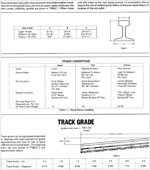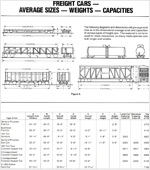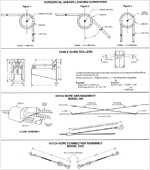Car pullers are rated and sold on the basis ot their pulling capacity in pounds at the drum, not on the number of cars they can pull.
Proper selection of a car puller for any particular application should be made on the basis of existing conditions and the requirements which must be satisfied.
The rope pull required is dependent upon several variables, weight and condition of cars to be handled, the grade, any track curvature or switches and the condition of track, and ambient temperature. A greater pull is required to start the cars than to keep them moving after being started. Normally the estimated rope pull required is that neces-sary to move the cars after they have been started, it is assumed that the starting capacity of the electric car puller is a minimum two(2) times the running capacity and sufficient to start the cars moving.
The following information has been tabulated to help determine the required rope pull of a car puller to suit the application and various conditions that exist. (Stanspec Corporation Engineering will be happy to size a system to suit your application upon request, providing accurate pertinent data of conditions and requirements are furnished.)
Required (Running) Rope Pull =W1(A + B + C) + W2(D) + W3(E)
Where: W1 = Maximum gross weight of cars
and contents (tons)
W2 = Maximum gross weight of cars and
contents within curved section of track (tons)
W3 = Maximum gross weight of cars
and contents within switches (tons)
A = Track Factor Loading (///Ton): Table 1
B = Grade Factor Loading (///Ton): Table 2
C = Temperature Factor Loading (///Ton): Table 3
D = Curve Factor Loading (///Ton): Table 4
E = Switch Track Factor Loading (///Ton): Table 5
Example:Criteria Given:
A car puller is required to move ten (10) loaded cars, each
having a live load of 35 tons with each car weighing 54,000 Lbs.
It will be necessary to pull through a 3° curve. A switch track
of 12° is present to pull onto siding. Track condition is fair, rail
is 115#. Lowest ambient temperature at location will be 20°F.
Entire track is on approximately 1% grade.
SOLUTION :
Rope Pull Required = W1(A + B + C) + W2(D) + W3(E)
Step I: Total weight of car =
35ton + 54000# = 62 tons
2000#
W1 =(10)(62) = 620
From Table One(1): Line pull per ton on a Fair track
condition
A = 15 Lbs.
Step II: From Table Two(2): Line pull per ton for a 1% grade
B = 20 Lbs.
Step III: From Table Three (3): Line pull per ton required for
operation in 20°F area
C = 3 Lbs.
Step IV: Assume car length to be approximately 50′-0″.
A 3° curve has a radius of curve of 1910 feet(from Table 4)
Circumference of
curve = (19l0x2)(3.1416)*3 = 100.00 Feet360Number of
cars in curve= Circum. of Curve = 100′ = 2Length of Car 50′
W2 =(2)(62 Tons)= 124 Tons
From Table 4: Line pull per ton for a 3° curve. D = 4 Lbs.
Step V: Approximate length ot curve in switch is 67 feet.
(From Table 6—12°curve — lead = 67 feet)
Number of
cars in curve = Lead = 67 = 1.34
Length of Car 50
W3 = Number of cars in curve x total weight of car.
=1.34 x 62 Tons= 83 08 Tons
From Table 5: Track curvature in switch is 12° —
per Note Figure 4: Add 2 Lbs. per
degree of curvature
E = 12° x 2 Lbs. = 24 Lbs.
Final Calculation
W1 = 620 tons(Slep I)
A = 15 Lbs.
B = 20 Lbs.(Step II)
C = 3 Lbs.(Slep III)
W2 = 124 tons(Slep IV)
D = 4 Lbs.
W3 = 83.08 tons(Step V)
E = 24 Lbs.
Formula:
Line Pull = W1(A + B + C) + W2(D) + W3(E)
= 620(15 + 20 + 3) + 124(4) + 83.08(24)
= 23560 + 496 + 1994 ±
= 26050 Lbs. of running line pull requited.













